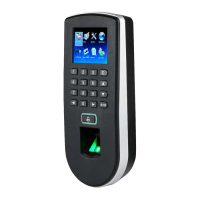
Do you have a question about the ZKTeco F19 and is the answer not in the manual?
| Model | F19 |
|---|---|
| Fingerprint Capacity | 3000 |
| Max User Capacity | 3000 |
| Transaction Capacity | 100, 000 |
| Access Control Interface | 3rd Party Electric Lock, Door Sensor, Exit Button, Alarm |
| Operating Humidity | 20% to 80% |
| Communication | TCP/IP, RS485 |
| Display | TFT LCD |
| Power Supply | DC 12V |
| Operating Voltage | DC 12V |
| Supported Readers | Fingerprint |
| Door Lock Control Output | 1 |
| Door Sensor Input | 1 |
| Exit Button Input | 1 |
| Alarm Output | 1 |
| Type | Fingerprint Access Controller |
Steps for preparing the wall and attaching the device's back plate and rubber pad.
Securing the device unit onto the mounting bracket and tightening the screw.
Device signals door unlock and detects door state for alarm triggers.
Alarm for illegal removal, support for external reader, exit button, and door bell.
Supports RS485 and TCP/IP communication for PC connectivity.
Wiring configuration for sharing power with the lock, specifying voltage and distance limits.
Wiring configurations for locks with different voltage or distance requirements.
Diagrams and labels for connecting external exit buttons, door bells, and door sensors.
Specifies DC 12V voltage and 500mA current for device operation.
Details the DC 12V output voltage for alarm signals.
Device supports standard Wiegand 26-bit output for access control devices.
Enables connection to a slave card reader for dual-side door control.
Guidelines for distance, grounding, and signal integrity for Wiegand connections.
Instructions on how to restart the device using the reset button.
Procedure to reset device settings using the tamper switch.
Details on using RS485 wire, converter, and bus-type wiring for PC communication.
Explains direct crossover cable and LAN/WAN switch connections for TCP/IP.
Important safety and operational advice for installation and use, including power connection and wire handling.
Recommendation for using a DC 12V/3A power supply for the device.
Advice on wire exposure, grounding, and cable type for long-distance installations.
